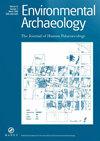移沙--早期伊斯兰教将凯撒利亚沙质低地改造为地块和护堤集水农业生态系统
IF 1.1
3区 地球科学
0 ARCHAEOLOGY
引用次数: 0
摘要
在早期伊斯兰时期,几项新兴的农业创新使人们能够在地中海贫瘠的土地上种植夏季作物。这就需要开发水田。本文章由计算机程序翻译,如有差异,请以英文原文为准。
Shifting the Sands – Early Islamic Modification of the Caesarea Sandy Lowlands into Plot-and-Berm Water-Harvesting Agroecosystem
During the Early Islamic period, several emerging agricultural innovations enabled the cultivation of summer crops in unproductive Mediterranean lands. This necessitated the development of water ha...
求助全文
通过发布文献求助,成功后即可免费获取论文全文。
去求助
来源期刊

Environmental Archaeology
GEOSCIENCES, MULTIDISCIPLINARY-
CiteScore
4.80
自引率
0.00%
发文量
32
期刊介绍:
Environmental Archaeology: The Journal of Human Palaeoecology aims to publish contributions on all aspects of environmental archaeology, from methodology to synthesis and theory.
Environmental Archaeology is an international peer-reviewed periodical which welcomes contributions that consider the interaction between humans and their environment in the archaeological and historical past. This broad scope embraces papers covering a range of environmental specialisms within archaeology, such as archaeobotany, archaeozoology (both vertebrate and invertebrate), palynology, geoarchaeology, biological anthropology, as well as more synthetic and theoretical approaches to the past human environment. Assemblage and site reports are not encouraged unless these can demonstrate significant new insights in environmental archaeology. Contributions may take the form of substantial research papers or shorter reports and may include, for instance, new techniques, philosophical discussions, current controversies and suggestions for new research. The journal also provides its readership with critical appraisal of recent academic scholarship through its regular books review section.
 求助内容:
求助内容: 应助结果提醒方式:
应助结果提醒方式:


